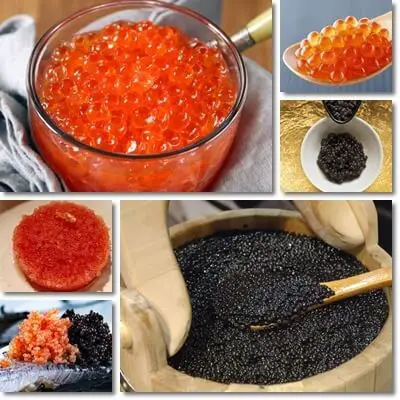Lumpfish eggs provide an economical alternative to the lavishly expensive wild sturgeon roe from which the most prized caviar varieties are made (such as Beluga, Ossetra and Sevruga or starry-sturgeon caviar). The eggs are sourced primarily from the Cyclopterus lumpus lumpfish or lumpsucker fish species found abundantly off the Atlantic Coast. While they are prepared in such a way to achieve likeness to caviar, including being dyed red and black, they are not, in fact, real caviar. However, nutritionally speaking, they are just as valuable as sturgeon or other fish eggs and provide similar health benefits.
What do lumpfish eggs look and taste like?
There’s a reason why they are dyed when turned into an affordable version of caviar: lumpfish eggs neither look nor taste very desirable. In their natural form, the eggs are jelly-like with an unappealing gray color and taste, well, like fish. They are smaller, comparable in size to sturgeon eggs (one important reason they are used for the production of affordable caviar products). When made into caviar, lumpfish eggs get dyed red or orange to resemble salmon roe or black to resemble the far more expensive sturgeon roe from which the most prized caviar varieties are made.

However, when the eggs are served together with other foods, the dyes used to color them tend to seep into those other foods. This can be considered evidence the eggs have undergone dyeing and may indicate an origin other than sturgeon or other expensive fish species. When preparing them for human consumption, lumpfish eggs are salted, similar to caviar. Depending on the final product they are made into, they may be pasteurized or not or experience other types of processing. The unpasteurized food product requires refrigeration as it’s subject to bacterial contamination as well as a potential source of parasitic diseases.
So what is the difference between lumpfish roe and caviar?
First of all, roe refers to (female) fish eggs in general. Lumpfish roe refers to the eggs of lumpfish just as they are. Caviar is a particular preparation of fish eggs from certain species, notably three species of sturgeon (Beluga, Ossetra and Sevruga or starry-sturgeon). Lumpfish eggs can be used to make a more economical food product similar to caviar, although it’s not actual caviar. Lumpfish roe and an affordable ‘caviar’ version are available for sale in many parts of Europe and the US.
In addition to having a lower price and providing fairly similar nutrition and health benefits (when they aren’t over-processed), there are also environmental advantages to choosing this less expensive option: helping re-establish declining sturgeon populations (lumpfish enjoy thriving populations). Indeed, the taste is inferior or, at least, not as fine, but lumpfish eggs and the caviar made from them can still provide a wonderful taste experience.

Lumpfish eggs health benefits and nutrition facts
1) Rich source of EPA and DHA Omega-3 fatty acids. Lumpfish eggs are important sources of healthy Omega-3 fatty acids. More important, they provide EPA and DHA, the two forms of Omega-3 the body needs the most. Both forms help make up cell membranes throughout the body and are physically present in the brain, hence the importance of getting enough of them for dietary sources, notably fish and fish eggs and other sources of seafood.
One of the biggest benefits of eating lumpfish eggs and fish roe contributing to brain health: Omega-3 fatty acids support normal brain function throughout adult life, notably aspects such as memory and learning, as well as help with brain development of babies in the womb. The fatty acids further hold extensive anti-inflammatory properties that benefit the cardiovascular system in particular.
2) Important source of selenium and iodine. One of the most notable aspects of lumpfish roe nutrition is a good selenium and iodine content which benefits thyroid health in particular. Iodine is essential for the production of thyroid hormones that regulate growth and other aspects of endocrine and general health. A deficiency causes too little thyroid hormones to be produced and leads to hypothyroidism, or an underactive thyroid manifesting through goitre (enlarged thyroid gland) and other health problems. Selenium is just as important for thyroid hormone production and supports thyroid health.
3) Dietary source of vitamin D. Lumpfish and other fish eggs are generally good sources of vitamin D and help meet nutritional requirements for the vitamin. In short, vitamin D has immune system-strengthening properties, helps fortify bones and teeth (together with calcium, phosphorus and magnesium) as well as enhances female fertility.
4) High in protein. Even as little as one tablespoon of lumpfish eggs or other fish eggs gets you several grams of protein containing all essential amino acids and non-essential ones too. The amino acids in protein are used by the nervous system to make up neurotransmitters that regulate various aspects of mental health, including mood, sleep and appetite. Protein is vital for building and repairing muscle and is used by the immune system to create white blood cells that fight infections and disease. Lastly, it assists with weight loss. But is lumpfish roe good for weight loss? In the amounts it’s meant to be eaten, no, it doesn’t produce weight loss. But it doesn’t encourage weight gain either.
5) Rich source of B vitamins. Animal products contain most, if not all B vitamins which provide benefits for the nervous system, boost energy and help repair skin. Vitamins B9 and B12 from lumpfish and other fish eggs are particularly good for pregnant women. Both ensure the proper development of the brain and nervous system of babies in the womb. Vitamin B9 in particular is known to help prevent neural tube defects of the brain, spine and spinal cord in newborns.
6) High in cholesterol. If eaten in the reasonable amounts it is meant to, lumpfish and other fish eggs provide adequate amounts of cholesterol which should in no way affect cardiovascular health. On the contrary, cholesterol helps protect against brain cell deterioration and helps maintain optimal brain function as a result. It further helps synthesize hormones, benefiting fertility and bones, as well as helps the body process vitamin D for a strong, healthy immune system.
7) Good source of potassium and phosphorus. Unless salted, lumpfish eggs promote good blood pressure numbers thanks to their content of potassium. They are a generous dietary source of phosphorus as well which contributes towards strong, healthy bones and teeth (with a lot of help from vitamin C, calcium and magnesium).
Lumpfish eggs side effects and contraindications
1) Allergic reaction with the potential for anaphylactic shock (a medical emergency that requires immediate assistance). Typically, those with existing allergies to fish and fish products are more likely to experience allergic reactions to lumpfish eggs. Complete avoidance of the allergen in all forms is the only solution.
2) Hypertension. High blood pressure is likely if the fish products are salted and eaten in excessive amounts. Salting lumpfish eggs cancels out the benefits for blood pressure provided by their good potassium content.
3) High cholesterol. Seafood in general, whether fish eggs, shrimp or shellfish, is an important source of cholesterol and fat in general. If consumed in unreasonable amounts, all types of fat cause weight gain and encourage high blood cholesterol levels.
4) Bacterial infection. If you eat raw, unpasteurized fish eggs or do not store them properly (even pasteurized products after opening the seal), there is always a chance of bacterial infection. Fish and seafood may contain Vibrio bacteria which cause gastroenteritis with infectious diarrhea when ingested or even sepsis when entering open wounds.
Lumpfish eggs and other types of fish roe and products made from them are not for babies, small children, pregnant women, the elderly or anyone with immunodeficiency. And the reason they are contraindicated is because they spoil fairly quickly and hold a high risk of bacterial contamination, producing gastrointestinal disease that can be a source of major side effects for these categories of people in particular.
Does lumpfish roe go bad even if it’s pasteurized? Yes, definitely. Even if it’s a pasteurized or otherwise cooked product, it can go bad in a matter of days or even hours. It’s vital that you refrigerate fish eggs products after opening them and never eat them after the recommended period of time, even if they’ve been kept in refrigerator conditions.
5) Parasitic infection. All seafood can potentially be a source of worms and intestinal parasites, some more dangerous than others. These can only be inactivated through pasteurization or proper cooking. Categories of people most at risk for complications from intestinal parasites infections include babies and small children, pregnant women, the elderly and anyone with immune system deficiencies.
